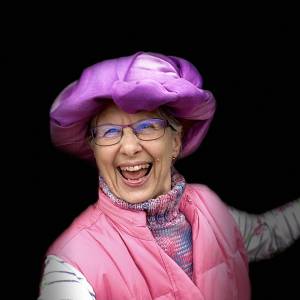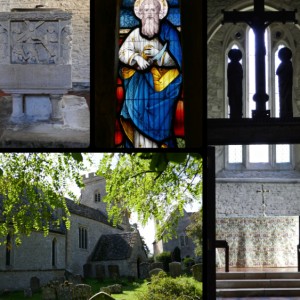A SEAT WITH A VIEW - SHILTON, OXFORDSHIRE
We had a good service at Church this morning when I was leading and we were thinking about how worshipping God focuses our wavering hearts. I had bought some wooden hearts and after leading a meditation, invited people to come and take a heart for themselves and also one or more to give to people during the week - see my extra photograph.
After the service, and on a rather grey day, we set off for Shilton, a pretty little Cotswold village with stone cottages and stone roofs, many of them very old, and which is about a mile and a half north west of Carterton. According to the Oxford Dictionary of English Place Names, the village name means “a farmstead on a shelf or ledge” and, given that much of the village is overlooking the Shill valley, this would appear quite likely. However, there is also conjecture that the village is named after the Shill Brook itself.
In the centre of the collage, you will see Mr. HCB sitting on a seat overlooking the ford across the Shill Brook and the stream forms a duck pond, which many rushes around the edge - but we didn’t see any ducks there today. However, we did sit and eat our sandwiches and were delighted to see some blue sky and the sun.
Opposite the seat, there is an arched stone footbridge so if you live on the other side of the village and are on foot, you don’t need to paddle through the ford. We both remarked that the water was very low because usually, there is water running through both arches of the bridge.
There is also another seat - top left of the collage - near the War Memorial and just in front of the remains of two pumps, one for buckets and one for barrels on carts, both of which were still in use until the 1930s, as was another pump just past the pub, The Rose & Crown, in the bottom middle photograph.
At the top right is Forge Cottage, which can also be seen from the seat and the part which has an old window was probably the actual forge - right in the centre of the village.
The lovely house shown in the middle top of the collage had the name Pump Close on the gate and is actually situated across the road and behind where Mr. HCB is sitting. We have often visited Shilton and I have photographed this cottage many times and have even used it on cards I have made.
I had printed off a Village History Trail and we decided to walk up to the 12th century Parish Church, the Church of the Holy Rood, which sits on a hill overlooking the village. It was quite a steep climb, but I am pleased to say I made it without too much bother.
The Church, shown at the middle left of the collage, is a Grade II Listed Building and the nave, south aisle and arcade are Norman, built in about 1150 with the present early English Gothic chancel being built in about 1250, the bell tower was added in the 15th century.
We did go into the Church, which was beautiful although quite unadorned as Churches go. Cistercian monks from the Abbey of Beaulieu were responsible for most of the church building work and also for many of the ancient buildings that comprise older Shilton.
The altar is the original 12th century Mensa or table, which would have probably been sited in the centre of the Chancel for the monks to kneel around when receiving the Sacrament. Interestingly, there is no stained glass window above the altar, the plain glass window is just engraved, which we thought was quite unusual.
The font is rather large, with large and intricate stone carvings, and dates back to the 13th century - apparently, in post-Norman times, they were used for the total immersion of children at baptism, something I didn’t know, but later, when it became customary just to pour water over the child, fonts were made higher.
I have put in an extra collage showing one of the stained glass windows, the font, altar and another view of the Church. As you can imagine, It was very hard choosing just a few photographs from over 100 that I took today.
The middle right photograph in the collage is the Vicarage, but we were not sure if it is still used as such - it was a very large house and may have been sold off by the Church at some point, but there was no-one around to ask.
At the bottom right is April Cottage, which was formerly The Bakery until the middle of the 20th century. At this property and at many others in the village, extensive building works are taking place, but it was good to note that they are all in keeping with the Cotswold stone used.
At the bottom left is The Old School, built in 1867 to cater for all the village children and when it first opened there were about 40 pupils. It closed in 1970 and was bought by the village to be used as a Village Hall in 1971. Opposite there, but not shown is Ivy Bank, the schoolteacher’s house, on the site of the old village pond; again, this was a very large house and we both said we wouldn’t like the heating bills for many of these large houses.
Shilton also has a small Baptist Chapel, but this was in another part of the village, so we didn’t see that today. Perhaps another time.
It’s interesting to note that the village was used as a location in the popular television drama, Downton Abbey - the Old Forge, beside the ford, became the Red Lion pub and the arched stone bridge also featured - something else I never knew - it’s amazing how much I am learning whilst taking shots of Seats with a View!
“There is a beautiful village
in every country.”
Lailah Gifty Akita
P.S. I apologise for the length of this, but I wanted to get everything in, so that it was interesting rather than just random photographs.



Comments
Sign in or get an account to comment.


